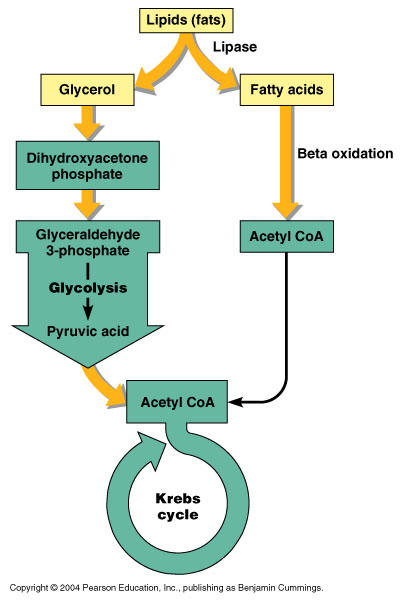Lipid catabolism, or lipolysis, is the process of breaking down the molecules of lipids into simpler ones, with release of energy. Under the influence of lipases (a type of enzymes), lipids break down into glycerol and free fatty acids (“Lipid and Protein Catabolism” n. pag.). These free fatty acids then become available for cellular uptake; they are bound by albumin and then transported to tissues and cells requiring energy (King n. pag.). Then, these fatty acids are β-oxidated and thus transformed into acetyl-CoA; the latter may undergo the Krebs cycle and be broken down further (“Lipid and Protein Catabolism” n. pag.). Meanwhile, glycerol can also be decomposed in the process of glycolysis (“Glycolysis” n. pag.).
Lipid anabolism, on the other hand, is the process of synthesizing the molecules of lipids from simpler ones so as to store energy. Lipids are synthesized from carbohydrates when there is an oversupply of them. In the process, fatty acids are created in the presence of synthases (catalyzing enzymes) from acetyl-CoA (“Lipid Biosynthesis” n. pag.). After that, these fatty acids are joined with a variation of glycerol, which results in a molecule of phosphatidic acid, to which a “hydrophilic portion of the lipid is added,” creating a molecule of a lipid (Paustian n. pag.). It is worth noting that certain lipids cannot be synthesized in some organisms, and must be obtained via food.
Speaking about the structure and function of lipids, it is worth pointing out that lipids are often hydrophobic, which allows them to be parts of cell membranes and form water-repellent integuments, and regulate the permeability of cells. At the same time, when decomposed, lipids produce a vast amount of energy, which is why they are used by most organisms to store energy.
To give an example, triacylglycerols (dietary fats) in the process of catabolism are broken down into two molecules of fatty acids and a molecule of monoacylglycerol in the presence of lipase. After that, the resulting molecules are transported into enterocytes (intestinal absorptive cells). There, they might be reattached again to form triacylglycerol, then be wrapped in proteins and transported around the body (“Lipid Metabolism” 1-2).
To better remember the general scheme of the processes of catabolism and anabolism, it is possible to use the following diagram:

Lipids break down into glycerol and fatty acids. Because fats are one of the main subclasses of lipids (basically, lipids are often associated with fats for most people), it is easy to remember that they decompose into fatty acids. It is also easy to remember that the breakdown requires lipases (catalysts) because of the similarity of names (lipids and lipases).
The process of lipid synthesis is similar to the process of decomposition turned backward. Lipids are created from fatty acids and glycerols in the presence of synthases, substances that catalyze this synthesis.
This topic is important for real life because lipids play a crucial role in living organisms. They form membranes of cells, store energy for further use, and perform numerous other functions. It is also essential that some organisms cannot synthesize certain lipids (which are, however, necessary for their vital functions), and must get them from food.
There is much current research on the lipids and their effect on the human organism. For instance, Konno and Munakata study the correlation between the levels of high-density lipoprotein cholesterol and the risk of cardiovascular disease and/or stroke development in Japanese population (874). Similarly, Park, Lee and Ovbiagele examine the effects of vitamin interventions on the levels of lipids and the risk of stroke and cardiac diseases in patients of a number of hospitals in the U.S., Canada, and Scotland (3270).
As it can be seen, lipids play important roles in disease control and prediction. Therefore, it is clear that studying the processes of catabolism and anabolism of lipids is crucial not only for understanding how e.g. the organism stores energy (which may be used, for instance, in food industry), but also for the advancement of medicine.
Works Cited
Glycolysis. n.d. Web.
King, Michael W. Lipolysis and the Oxidation of Fatty Acids. 2016. Web.
Konno, Satoshi and Masanori Munakata. “High-Density Lipoprotein Cholesterol Might Be a Better Predictor of Stroke than Other Lipid Measures in the General Japanese Population: The Watari Study.”International Journal of Cardiology 203 (2016): 874-876. Web.
Lipid and Protein Catabolism. n.d. Web.
Lipid Biosynthesis. n.d. Web.
Lipid Metabolism. n.d. Web.
Park, Jong-Ho, Juneyoung Lee and Bruce Ovbiagele. “Nontraditional Serum Lipid Variables and Recurrent Stroke Risk.”Stroke 45.11 (2014): 3269-3274. Web.
Paustian, Timothy. Fatty Acid and Lipid Synthesis. 2000. Web.